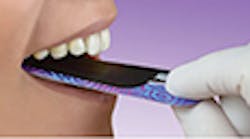By: Nicole Giesey, RDH, MSPTE
Having a high spot on a filling or crown is not so fun. It is painful. Preventing the old “high spot” is a crucial step with any restorative appointment. Sometimes when the patient is laying back and is still anesthetized they feel like everything feels good, but the old high spot is lurking within and goes unnoticed. That is, until they eat or the anesthetic wears off. Sometimes patients feel like their bite will just adjust itself and suffer for days. Sometimes they have a recare appointment right around the corner and wait to say anything until they come to see us.
As hygienists, we often fall into a routine with our daily schedules. Every so often we might have the opportunity to help out the doctor with their procedures and sometimes we have a patient in our chair with a non-hygiene problem. When patients come into the office for their recare appointments, occasionally they have an unknown pain that they would like checked out. Sometimes they are having a nagging problem that will not go away and rely on us, their providers, to help solve and fix their painful situation. When the issue is malocclusion for a high spot in their occlusion, we must first help narrow down where the pain is coming from so it can be adjusted. This is an easy and also helpful task to complete prior to the doctor’s exam so that you can accurately provide the dentist with a description and clinical evidence of the area in question. Assessing the situation first also allows you to get any necessary instruments and handpieces ready to quickly resolve the problem if a simple occlusal adjustment is needed to correct the issue and take away the pain. Looking ahead for your doctor and saving those minutes by being set up for the adjustment will be appreciated when they are on the fly and in the middle of a busy and hectic day.
The first step is to find out where the problem is and get a history on the situation. If the patient just had fillings or a new crown placed, chances are the bite is just not right. Checking the occlusion will be your next step to pinpoint the high spot. Taking good articulation is a breeze when you are using the right tools. The handy cotton pliers and cotton roll is a good place to start. Have the patient give you a generalized area that is bothering them and start your investigation. Dry off the teeth with the cotton roll and use a thin articulation film for accuracy like Bite-Chek® from Microcopy. This articulation film is more than a film. It is a sturdy accurate film with a holder built it. The holder, or built-in handle, saves a step of handling metal forceps to hold the film. This swift design will prevent the patient from biting into the forceps while checking their occlusion. The patient is already in the office for a bite issue, why intensify it with running the risk of biting on a forcep. Ouch. After the bite is checked and your area is pinpointed, your boss will be able to hear your assessment which will quickly make you the hero of the day.
Checking occlusion does not only occur for hygienists on the occasional prophy appointment. If we are placing sealants, checking occlusion is just as important as the sealant placement itself. The old saying that it will just wear down is not so true. Again, checking the occlusion is such an easy task. There is no excuse not to complete it. After all sealants are placed, check the occlusion. Use the articulation film as mentioned before when you have a patient with a high level of saliva. The film will not break
down as easy as the others on the market. By using this film you will be able to check the occlusion multiple times between adjustments to make sure the bite is right and the patient will not have any discomfort afterwards with the bite.
Simple steps of checking occlusion will not only save the patient a bit of pain, it will save the office the precious chair production time and money. Staying ahead of the game and practicing Best Practice measures will benefit all in the malocclusion fight but if a patient does have a high spot, you will be prepared and organized with the tools to help everyone in the situation.








